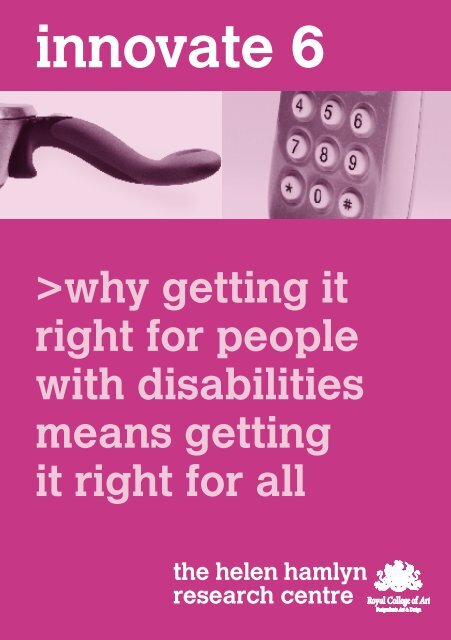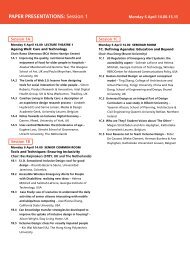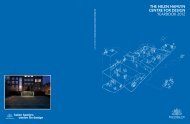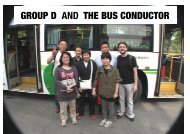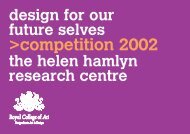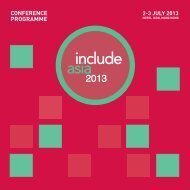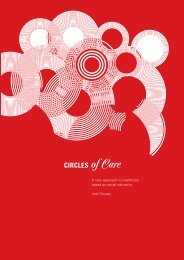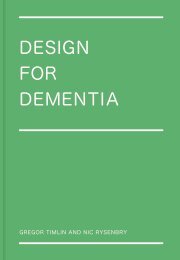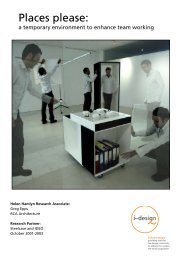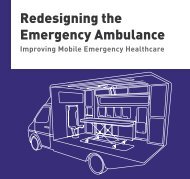innovate 6 - Helen Hamlyn Centre - Royal College of Art
innovate 6 - Helen Hamlyn Centre - Royal College of Art
innovate 6 - Helen Hamlyn Centre - Royal College of Art
- No tags were found...
You also want an ePaper? Increase the reach of your titles
YUMPU automatically turns print PDFs into web optimized ePapers that Google loves.
<strong>innovate</strong> 6>why getting itright for peoplewith disabilitiesmeans gettingit right for allthe helen hamlynresearch centre
spring 2004issue 6Innovate is the research and developmentjournal for small firms in the care anddisability sector. It is published twice ayear by the Small Business Programme <strong>of</strong>the <strong>Helen</strong> <strong>Hamlyn</strong> Research <strong>Centre</strong> at the<strong>Royal</strong> <strong>College</strong> <strong>of</strong> <strong>Art</strong>, LondonThe <strong>Royal</strong> <strong>College</strong> <strong>of</strong> <strong>Art</strong> is the world’s only whollypostgraduate university <strong>of</strong> art and designThe <strong>Helen</strong> <strong>Hamlyn</strong> Research <strong>Centre</strong> isdedicated to the study and practice <strong>of</strong> sociallyinclusive designThe Small Business Programme <strong>of</strong> the <strong>Helen</strong><strong>Hamlyn</strong> Research <strong>Centre</strong> works with small firms,primarily in London and the south-east, to identifyand exploit innovation opportunities in responseto social and demographic change. Its key focusis new product and service development in thecare and disability sectors. It is funded by HEFCE’sHigher Education Reach-Out to Business and theCommunity Fund (HEROBC)2
Julia CassimEditor, Innovate,Research Fellow, <strong>Helen</strong><strong>Hamlyn</strong> Research <strong>Centre</strong>>editorialWelcome to the latest issue <strong>of</strong> <strong>innovate</strong>which describes the six new designprototypes generated by the DBA DesignChallenge 2003, a joint initiative betweenthe Design Business Association and the<strong>Helen</strong> <strong>Hamlyn</strong> Research <strong>Centre</strong> at the<strong>Royal</strong> <strong>College</strong> <strong>of</strong> <strong>Art</strong>.Now in its fourth year, the DBA DesignChallenge has become one <strong>of</strong> the mosteagerly awaited events in the designcalendar and an important catalyst forinclusive design. More design firms thanever before lined up to take part and theshortlisted projects proved beyond doubtthat working closely with key user groupscan unlock hidden innovation potential innew products and services.Designing inclusively for the mainstreamwhile including the needs <strong>of</strong>disabled people is tough. Why do thedesigners take up the challenge? One canthink <strong>of</strong> the Disability Discrimination Act,due to become law in October 2004.This will have huge implications forthousands <strong>of</strong> small firms both in the way1
2they treat their staff and in the servicesthey provide to their many disabledcustomers. There is also growingpressure from investors and the publicfor a greater focus on corporate socialresponsibility whatever the size <strong>of</strong> thecompany.But Rory Cellan-Jones, BusinessCorrespondent <strong>of</strong> BBC News, expressedit best in his keynote speech at the event:‘It is not just about blue sky thinkingby a few design geniuses who closetthemselves away for a few months beforeemerging to delight their customers withirresistible new products that they neverknew they really needed. It is aboutputting designers and users together in aco-operative process knowing that, if weget it right for disabled people, then weget it right for most people.’Getting it right for most peopledrives the six dynamic projects describedin the following pages. Read on...
contents41316192226293132DBA Design Challenge 2003project one: Factory Waresproject two: Eyespeakproject three: Digital Wayfindingproject four: Life Circleproject five: Ello – Inability not Disabilityproject six: Buddy, the ‘Active’ Companionlooking aheadweb resources3
44>DBA Design Challenge 2003When six British design consultancies –all members <strong>of</strong> the Design BusinessAssociation – took up the challenge <strong>of</strong>inclusive design, their shared objectivewas to design for the mainstream marketwhile including as many people as possible,especially those with disabilities.Inspired by design briefs set by the<strong>Helen</strong> <strong>Hamlyn</strong> Research <strong>Centre</strong>, theirproposals were shortlisted from a recordtotal <strong>of</strong> 14 entries submitted. After a rapidthree-month development period lastautumn, their projects were unveiled toa capacity audience drawn from the worlds<strong>of</strong> design, disability, government andbusiness at the <strong>Royal</strong> <strong>College</strong> <strong>of</strong> <strong>Art</strong> on9 December 2003.
Judges6> how well social inclusion was promoted> the depth <strong>of</strong> insight shown into theneeds and aspirations <strong>of</strong> excluded groups<strong>of</strong> people> the creative use <strong>of</strong> user input> how well the key ideas were communicated.The prototypesFor the first time, the DBA Design ChallengeInclusive Design Award was shared by twoproduct design consultancies: FactoryDesign for Factory Wares, a reinvention <strong>of</strong>the saucepan; and Seymourpowell for Ello,an inclusive mobile phone.The judges were impressed by FactoryDesign’s courage in taking an everyday,unromantic object and, in the short timeframe <strong>of</strong> the project, transforming it intoone that would enhance independence andquality <strong>of</strong> life for those with reduced gripand strength.The panel felt that the design team ‘setthe standard’ for the Design Challenge in arigorous process that resolved the hierarchyand complexity <strong>of</strong> the issues identified in theuser groups, translating them seamlessly intoa high-quality mainstream prototype.As for Seymourpowell’s Ello, the judgesJohn Mathers, President,Design Business AssociationNick Rawcliffe,Interaction DesignerHilary French, Head <strong>of</strong>School <strong>of</strong> Architecture &Design, <strong>Royal</strong> <strong>College</strong> <strong>of</strong>
JudgesLynda Relph-Knight, Editor,Design WeekDavid Yelding, Director,RicabilityRama Gheerawo,Research Fellow, <strong>Helen</strong><strong>Hamlyn</strong> Research <strong>Centre</strong>found it wonderfully refreshing, to hear thepowerful message <strong>of</strong> ‘less is more’ in regardto mobile phone technology from two youngdesigners.They were impressed by the designers’willingness to strip the mobile phone downto its essentials, eliminate those elementsthat wouldn’t fit, and craft a beautiful,sensual object that worked at the aestheticand functional levels. The judges liked thephone’s tactile buttons, its intuitive featuresand felt it could have as much impact on themarketplace as BT’s Big Button telephone.Lewis Moberly, an independent brandidentity consultancy with <strong>of</strong>fices in London,Paris and Geneva, developed Eye Speak –a communication device to transmit a visuallanguage. Its aim is to facilitate non-verbalcommunication in noisy environments whereconventional means are ineffective or wherehearing impairments can lead to socialexclusion.The judges felt that the design teamhad identified a neglected area that disableseveryone, not just the hard <strong>of</strong> hearing. Theywere impressed by their willingness to goback to first principles, look at non-verbalsigning systems and extract those elementsthat were crucial to the aspirational and7
8functional needs <strong>of</strong> the users with whomthey had worked. The result: an elegantlanguage <strong>of</strong> symbols, with great mainstreampotential, backed by a simple device thatassists communication in the most positive,non-stigmatising way.Leading transport graphic designersRoundel partnered Dalton Maag, recognisedexperts in font design, in the DBA DesignChallenge. Together they developed the firstmuch-needed set <strong>of</strong> protocols for electronicfont displays in a project entitled DigitalWayfinding.The panel felt they displayed a mastery<strong>of</strong> the key sensory, visual, cognitive andenvironmental issues facing the new andas-yet unregulated area <strong>of</strong> digital signage,which impacts so negatively on the travellingpublic. Within the limited time frameavailable for the project, they devised aninvaluable set <strong>of</strong> guidelines for designers,entering an area where engineering has longheld sway. The judges felt that the guidelinescould set new standards for the way thatthe design pr<strong>of</strong>ession will work in this areain the future.Creative consultancy Seachangeproposed Life Circle, a communicationsystem coded for chronic conditions whichThe DesignersPaul Backett and JamesSamperi, SeymourpowellPaul Cilia la Corte,Lewis MoberlyTom Wilson and Roger Rundle,The Team
The DesignersTony Howard,RoundelGavin Thomson,Factory DesignSally Costen,Seachangeencourages compliance in taking prescribedmedicines. The project aims to reducemedical emergencies stemming fromhuman error.The panel was very impressed by thedesign team’s willingness to take on anincreasingly complex subject, identify theseparate needs <strong>of</strong> the stakeholders at eachlevel <strong>of</strong> the system, and translate these intoconcepts that were brilliant, yet simple andeffective. The judges felt that Life Circle, ifadopted by the industry, could holistically– and dramatically – resolve some <strong>of</strong> thepsychological, systemic and financial issuesthat lead to non-compliance.Last but not least <strong>of</strong> the six projects wasBuddy, proposed by brand communicationconsultancy The Team. Buddy is a wearablemobile device with vibration alerts that warnthe hearing impaired user when alarms go<strong>of</strong>f in the vicinity, helps distinguish betweenthem and allows informed decisions andaction to be taken.The judges felt that Buddy directlyaddressed the user’s emotional and physicalneeds by simultaneously reducing theirvulnerability and enabling new levels <strong>of</strong>independence and peace <strong>of</strong> mind. Of allthe projects, this was one that tackled an9
‘Anything which involves getting agreater understanding <strong>of</strong> how customersuse business services has to be good for thebottom line.’Rory Cellan-Jones, Business Correspondent,BBC Newsemotive subject extremely well.The panel felt that the idea, with its use<strong>of</strong> simple, usable technology, had greatpotential as a mainstream product, goingway beyond the hearing impaired communityit was perhaps intended to serve.10The speakersJulia Cassim <strong>of</strong> the <strong>Helen</strong> <strong>Hamlyn</strong> Research<strong>Centre</strong> welcomed the capacity audience andintroduced the event. She paid tribute to theenergy, creativity and commitment <strong>of</strong> thedesign teams who had worked on a voluntarybasis to develop the projects. Equallyimportant, she said, were the dedicated andgrowing network <strong>of</strong> disabled users, many <strong>of</strong>whom had travelled considerable distancesto take part in the focus groups that are animportant part <strong>of</strong> the whole process.
‘I just feel quite privileged to be part <strong>of</strong> whatyou are trying to do, not just for ourselvesbut for the next generation <strong>of</strong> disabledpeople to come.’Michelle Rivers, Sensory Disabilities Team,Wandsworth CouncilRory Cellan-Jones, Business Correspondent<strong>of</strong> BBC News, chaired the eventand made the keynote speech. He describedthe event as ‘a combination <strong>of</strong> the Oscarsand Olympics <strong>of</strong> the inclusive design world’and went on to contrast the performance <strong>of</strong>companies who had taken up the inclusivedesign message and found their marketsexpand with those who had ignored it.Michelle Rivers <strong>of</strong> Wandsworth Council’sSensory Disabilities Team and a veteran <strong>of</strong>the DBA Design Challenge’s user forums,responded to the presentations. She stressedthat the experience <strong>of</strong> working with disabledpeople as part <strong>of</strong> an inclusive designapproach would help designers in tacklingthe future needs <strong>of</strong> an ageing population, asdisabilities were inherent to ageing.John Mathers, President <strong>of</strong> the Design11
‘At a personal level this award programmefeeds the soul and taps into the passiondesigners have to solve problems. Onanother, it creates viable new businessopportunities... all <strong>of</strong> the stories act asinspirational case studies to encouragedesign consultancies and businesses toreassess their thinking and processes toembrace a more diverse customer base.’Deborah Dawton, Chief Executive,Design Business AssociationBusiness Association, presented the awards,designed by former <strong>Helen</strong> <strong>Hamlyn</strong> ResearchAssociate Mary Wagstaff. He thankedthe teams for all the ‘time, sweat andconsideration that had gone into eachand every project.’12
project one:Factory Waresby Factory DesignA project that returns to first principlesto design an inclusive, commerciallysensitive and delicious-looking saucepan.The users with severe arthritis whoadvised Factory Design all loved cookingbut their moment <strong>of</strong> truth came once thedish was ready and had to be lifted from theheat. It was then that the weight and design<strong>of</strong> the saucepan increased the pain <strong>of</strong> theircondition and led to accidents.13 13
Nine million people <strong>of</strong> all ages in theUK are affected by arthritis and every one<strong>of</strong> them needs to eat. Factory Design’schallenge was to create a saucepan thatwould transform the pain <strong>of</strong> their cookingexperience to one where pleasure isuppermost.User inputUsers with severe arthritis (see right).User issues> A multipurpose pan with built-incolander desired> Many saucepans have a painful split inthe handle> Radius at bottom <strong>of</strong> pan too tight, makingit difficult to clean> Weight, handling, balance and draining arecommon problems.14How does it work?> Universal pan size to accommodatedifferent cooking methods> Traditional round shape but with conicalsides for easy pouring and a large radiusto facilitate cleaning> Aluminium body for lightness, non-stickinterior and copper bottom to enhance
‘When we first started,we had an open mind.We didn’t go in with anypreconceptions; we purposefullykicked <strong>of</strong>f theproject taking on boardthe feedback from the usergroups. We were lookingat two-handed operationinitially and realised that, tobe truly inclusive, we hadto make it as effective withone hand and then identifysecondary use with twohands.’Gavin Thomson, Factory Designcooking and cleaning> Integrated aluminium colander for drainage> Two-part lid in transparent lightweightpolycarbonate and aluminium withhooped handle that is easy to lift. The lidupends to make stacking easy> Ergonomic two-part long handle with afuller cross-section to assist gripping andangled downward for intuitive use.> Oval comfort platform at the end shiftsthe weight <strong>of</strong> the pan to the arm from asingle point at the wrist, ensuring greaterbalance, safety and less pain> The handles main structural shroud made<strong>of</strong> lightweight heat-resistant material overlaidwith tactile foam-filled polyurethaneto enhance gripping> Secondary hooped handle on the oppositeside for two-handed use.15
16>project two:Eye Speakby Lewis MoberlyA project that develops a visual languageto facilitate non-verbal communicationin noisy environments, using a hand-heldcommunications device.Clubs are places <strong>of</strong> fun and social liberationwhere the environment is enhanced bythe music and the atmosphere – but the keypleasurable ingredient <strong>of</strong> communicationcan be hampered by the very elements thatmake such leisure venues enjoyable. Noise
can drown out speech and crowded spacescan leave body language open to misinterpretation.Lewis Moberly looked at how universalpictograms could be developed into a visuallanguage to facilitate non-verbal communicationin noisy environments, using acommunications device to transmit thesymbols.User inputHearing-impaired and wheelchair users.User issues‘When I approach a ticket counter and theyhave a glass panel, I can’t understand whatthey are saying. Sometimes the loop systemis not working.’Caroline Appleby, Hearing Concern‘Whatever you come up with needs to bevery cool and very slick.’Matt Brown‘There are a lot <strong>of</strong> deaf people out therewho want to speak to hearing people butthey are too shy.’Troi Lee, organiser Deaf Raves17
‘The main purpose <strong>of</strong> Eye Speak and thevisual language is to embrace as many peopleas possible. The language <strong>of</strong> symbols hasexisted from cave paintings, thousands <strong>of</strong> yearsago ... Our technology was inspired by thei-pod, which has a lot <strong>of</strong> symbols. All we triedto do was to simplify the process <strong>of</strong> finding theicons, so that you could make your messagesvery quickly, and to make it fun.‘Paul Cilia La Corte,Lewis MoberlyHow does it work?Lewis Moberly developed an inclusivelanguage <strong>of</strong> symbols to enhance the ability<strong>of</strong> those, whether hearing impaired or not,to get about or get together in environmentswhere ambient noise or broadcast soundmakes communication difficult. The productconcept is for a small electronic device thatfits into the palm <strong>of</strong> the hand or slips into apocket. Signs, symbols and pictograms canbe accessed from a database <strong>of</strong> categoriesvia the touch screen and arranged in syntaxto form sentences.The design team drew on existingpictogram-based vocabularies ranging fromMakaton (www.makaton.org) used by thosewithout speech to universally recognisedsignage in general use. They addedabbreviations, numerals and some newvisual concepts. To aid legibility, theonscreen characters are in black and white.18
project three:Digital Wayfindingby Roundel/Dalton MaagA project to develop design protocols forelectronic font displays.In the mistaken belief that moreinformation means better communication,a wide variety <strong>of</strong> electronic media havereplaced traditional signage in public places.Dot matrix displays, CRT screens, digitalprojection systems, LCD and plasma displaysare installed with little thought given toconsistency, readability or perceived authority.New display technology <strong>of</strong>fers thepotential to do whatever you want but italso creates more opportunity for things to19 19
go wrong. The problem is particularly acutein large transport terminals where confusingor illegible signage impacts negatively onour ability to understand where to go next.Design cannot resolve the myriad problems<strong>of</strong> public transport in the UK but it can dosomething to improve the typographicquality <strong>of</strong> digital signs.Roundel and Dalton Maag, bothrecognised experts in the field, collaboratedto develop long overdue design protocolsfor electronic signage that will help designers,commuters and computer users, and whichshould set the standard industry-wide.User inputRegular travellers with vision and mobilityimpairments.20User issues> Information confusing or contradictory> Screen positioning problematic> Level <strong>of</strong> illumination for display too lowsince it is intended for home or <strong>of</strong>fice use> Screen glare and reflections render signsillegible> Technology not designed to display type> Resolution on plasma screen/CRT is poor> Scrolling confusing and disliked.
Tony Howard, Roundel‘When we started we thought we were just goingto design a typeface that would display reallywell on digital screens and improve thedecipherability <strong>of</strong> information for everybody.When we looked into it, we found out thatthe problem was much, much bigger than wethought, but the user group convinced us that itreally was worth looking at.’Recommendations> Maximum angle for reading overheadsigns should be 30º from the horizontal> Screens should be angled downwards toreduce glare with reflections from floorsand walls taken into consideration> Non-reflective glass to be used and angle<strong>of</strong> adjustment variable for each screen> Sign should be positioned to avoid directlight from windows, glazed ro<strong>of</strong>s andoverhead lighting> Consistency in graphic presentation,language and physical presentation> Humanist sans serif typeface preferableto Grotesque> Spacing <strong>of</strong> words kept loose tocompensate for larger viewing distances> DMR (Dalton Maag Roundel) typefacedeveloped as example <strong>of</strong> best practice> Few but consistent colour changes withtest pages converted to greyscale tocheck for contrast and tested in actualenvironment> Scrolling should be vertical not horizontal,with transitional fade in/fade outpreferred.21
project four:Life Circleby Seachange22A visual coding and communication systemfor use in both traditional and electronicmedia that will encourage compliance bythose with chronic conditions in takingtheir prescribed medicines.Each year there are 125,000 deathsworldwide among those who fail to taketheir prescribed drugs correctly. The overallcost <strong>of</strong> non-compliance is estimated at
£60 billion. The problem is particularly acuteamong those who must follow complex,timed regimes for such chronic conditionsas diabetes, asthma or arthritis.Forgetfulness, insufficient instructionsby the doctor, packaging that is difficult toopen and mystifying small print instructionsall play a part in this daily drama. Seachangeresponded holistically to the life-and-deathnature <strong>of</strong> the issue by developing an interlinkedcommunication and visual codingsystem to be used by all the stakeholdersinvolved in taking prescribed medicines. Thesolution aims to encourage compliance andreduce medical emergencies resulting fromhuman or systemic error.User inputUsers <strong>of</strong> different ages with such chronicconditions as arthritis, multiple sclerosisand asthma.User issues> Delays in prescription reissue can becatastrophic> Current system relies on the patient’sability to collect the prescription in personand then self-administer> Timing <strong>of</strong> complex drug regimes for chronic23
conditions reliant on fallible human memory> Information divided between differentstakeholders but not necessarily shared> No visual code to indicate generic typesto user or prescriber alike.24How does it work?Seachange envisages the following five-stepvisual coding and alert system:> Step 1 – The patient and GP personalisethe information and any necessaryupdates. This information is storedelectronically on a central server to allowaccess by the GP, pharmacist or emergencyservices. The details are downloaded toa chip and held in smart card or otherformat <strong>of</strong> the patient’s choice> Step 2 – An alert message is sentautomatically to the pharmacy when aprescription issue or renewal is due> Step 3 – A coded alert message is sentfrom the pharmacy to the patient’s chosendevice to signal that the prescription is
eady for collection. The hierarchicalicon system indicates the nature <strong>of</strong> thealert – whether it is for information,confirmation or an emergency> Step 4 – Relevant information about thedrug and its regime is transferred to thelabel with icons for quick identification.> Step 5 – The patient collects theprescription from the pharmacy usingthe smart card for identification.Sally Costen, Seachange‘We issued some questionnaires to GPs andpharmacists, alongside holding the user forum.The answers came back saying this is needed.The precise format and manner is something thatwe will probably take some time to find out. Butthe response so far has surprised me. There is aneed to get a communication line that overcomesthe disparate aspects <strong>of</strong> the health service.Among the drug companies, there is interest andI think there is opportunity.’25
26>project five:Ello – Inability notDisabilityby SeymourpowellAn inclusive mobile phone designed toaddress the needs <strong>of</strong> the widest possibleaudience, irrespective <strong>of</strong> age or ability.
Mobile communciation devices havetransformed our lives. The mobile phonein particular is vital to the ability <strong>of</strong> disabledpeople to remain independent yet stay intouch. However, with each new model thefeatures multiply while the product shrinks insize in the mistaken belief that this is what allconsumers want.Seymourpowell stripped the mobilephone down to its essentials. Its design focuswas to create a device that would becommercially viable and intuitive to use andcapable <strong>of</strong> instilling confidence in the user.User inputMobile phone users and non-users witharthritis and visual or mobility impairments.User issues> Technophobia> Inability to access even simple functions> Operation not intuitive> Buttons too small, hampering quick andaccurate operation> Interface too complex.How does it work?> Compact folding device with easy-to-open‘book edges’ for one-handed use27
Ready to use when opened> Keypad rises when opened for increasedtactile feedback> Prominent five key is convex and the restconcave for easy navigation> Border <strong>of</strong> key lights up to indicate numberhas registered> Clear contrasting graphics> Dedicated memory keys> Audio and visual feedback when operationis successful> One memory key flashes when caller isknown> Three keys light up and the phone vibrateswhen caller unknown> One button direct link to voice mail> Button pops up to indicate new message> Slider adjusts ringer volume by coveringor exposing speaker> Larger speaker gives better sound qualityand improves performance when there isambient noise> Gauge on front shows proportional level<strong>of</strong> battery power> Cradle recharger eliminates need to plugin each time> Increased battery life through elimination<strong>of</strong> screen.‘We tried to create apackage that would enablepeople to do the simplethings well and easilyand we tried to make theinterface more intuitive,more accessible.’James Samperi (above right),Seymourpowell‘All the functions andaspects <strong>of</strong> the phonewe wanted to incorporatewould be things peoplewould understandautomatically, and notinclude systems that wouldrequire explanation orlearning. ‘Paul Backett (above left),Seymourpowell28
project 6:Buddy, the ‘Active’Companionby The TeamA mobile alert system for people with andwithout hearing impairments, consisting <strong>of</strong>a wearable device with a smart switchingsystem that warns the user when alarmsgo <strong>of</strong>f in the vicinity.An estimated one in seven people inthe UK has a hearing impairment and nearly700,000 are pr<strong>of</strong>oundly deaf. As our populationages, these numbers will increase. Notall will wear hearing aids but all will need tobe aware <strong>of</strong> and enabled to deal with lifethreateningevents. The Team designed a2929
‘wearable’ mobile device based on simple,readily available technology that will to helppeople to distinguish between differenttypes <strong>of</strong> audio alerts, allowing informeddecisions and action to be taken.User inputUsers with hearing and visual impairments.User issues> Inability to hear alarm or alert> No differentiation possible between them> Inability to understand direction or source<strong>of</strong> sound> Feelings <strong>of</strong> vulnerability through inabilityto sense danger.How does it work?> Wearable paging device clips into holdingstructure <strong>of</strong> choice> Device can be worn on wrist or as pendantor badge> Device vibrates when alarm sounds> Symbols appear to differentiate type <strong>of</strong>alarm or alert> Possible inclusion <strong>of</strong> inaudible travelinformation from tannoy systems etc> Simple, existing, usable technology.‘We have had meetingswith a leading mobilecommunication companywho seems to think it ispossible. It would just bea question <strong>of</strong> recognisinga certain pitch and frequencyand intensity andduration. So I think it isvery critical.’Tom Wilson (above right),The Team‘There are examples thatillustrate the productworking … <strong>of</strong> a noisyfactory environment wherepeople couldn’t hear thetea bell alarm going and avibrating pager would go<strong>of</strong>f on their hip … So thetechnology exists on localnetworks. Our challenge isto make it much broader.’Roger Rundle (above left),The Team30
Educate to eradicate theguinea worm – entry to theDesign for our Future SelvesAwards 2004 from LeahHarrison, RCA Communication<strong>Art</strong> & DesignVisitors to the <strong>Helen</strong> <strong>Hamlyn</strong>Research <strong>Centre</strong>’s stand at theMobility Roadshow 2003>looking aheadStudent awardsVisit the <strong>Royal</strong> <strong>College</strong> <strong>of</strong> <strong>Art</strong>’s annualsummer show from 25 June to 4 July 2004to see how RCA students from all designdisciplines have responded to working withusers <strong>of</strong> all ages and abilities in the <strong>Helen</strong><strong>Hamlyn</strong> Research <strong>Centre</strong>’s Design for ourFuture Selves Awards. With a record 80shortlisted entries, the class <strong>of</strong> 2004 promisesa host <strong>of</strong> inclusive new products andservices for the care and disability sector.The Awards will be presented at the RCAon Tuesday 29 June. To attend the awardsceremony, contact: hhrc@rca.ac.ukMobility RoadshowAlso not to be missed is the <strong>Helen</strong> <strong>Hamlyn</strong>Research <strong>Centre</strong>’s exhibition at the twoMobility Roadshows to be held in 2004:17-19 June at Donington Park, Derbyshire;and, for the first time, in Scotland – 9-10July at the <strong>Royal</strong> Highland <strong>Centre</strong>, Ingliston,Edinburgh. It is a chance to get an overview<strong>of</strong> the work <strong>of</strong> the <strong>Centre</strong> and see some <strong>of</strong>the prototypes developed by RCA studentsand the design teams featured in this issue<strong>of</strong> <strong>innovate</strong>.31
web resourcesParticipating design consultanciesand organisations:www.bcab.org.ukwww.dba.org.ukwww.daltonmaag.comwww.factorydesign.co.ukwww.lewismoberly.comwww.roundel.comwww.seachangecreative.comwww.seymourpowell.comwww.theteam.co.ukDesign guidance/inclusive design:Inclusive design special collection:www.hhrc.rca.ac.uk/resources/special_collection/index.htmlInclusive design education resource:www.designcouncil.info/inclusivedesignThe <strong>Centre</strong> for Universal Design:www.design.ncsu.edu/cudGeneral:www.disabilityaware.orgwww.design-engine.comwww.access2go.co.ukwww.usabilityfirst.comwww.sonicrim.comTypography:www.readregular.comwww.tiresias.orgInteraction design:www.stakes.fiwww.iarchitect.comwww.etsi.orgHearing:www.rnid.org.ukwww.hearingconcern.comVision:www.rnib.org.ukwww.labs.bt.com/people/rigdence/colourswww.toledo-bend.com/colorblind/Ishihara.htmlProduct & Packaging:www.ricability.org.ukwww.dti.gov.ukwww.pira.co.ukDesign guidance for consideringolder people’s needs:www.tbchad.comwww.ace.org.ukwww.ageing.org32
The <strong>Helen</strong> <strong>Hamlyn</strong> Research<strong>Centre</strong> at the <strong>Royal</strong> <strong>College</strong> <strong>of</strong> <strong>Art</strong>is a centre for inclusive design. Funded bythe <strong>Helen</strong> <strong>Hamlyn</strong> Foundation, it collaborateswith RCA staff and students and a range<strong>of</strong> external partners to explore thedevelopment <strong>of</strong> socially inclusive productsand services for future ways <strong>of</strong> living,working and communicatingDesign: Margaret DurkanPrinting: Futura Printing Ltd33
The <strong>Helen</strong> <strong>Hamlyn</strong>Research <strong>Centre</strong><strong>Royal</strong> <strong>College</strong> <strong>of</strong> <strong>Art</strong>Kensington GoreLondon SW7 2EUT 020 7590 4242F 020 7590 4244hhrc@rca.ac.ukwww.hhrc.rca.ac.uk 34


